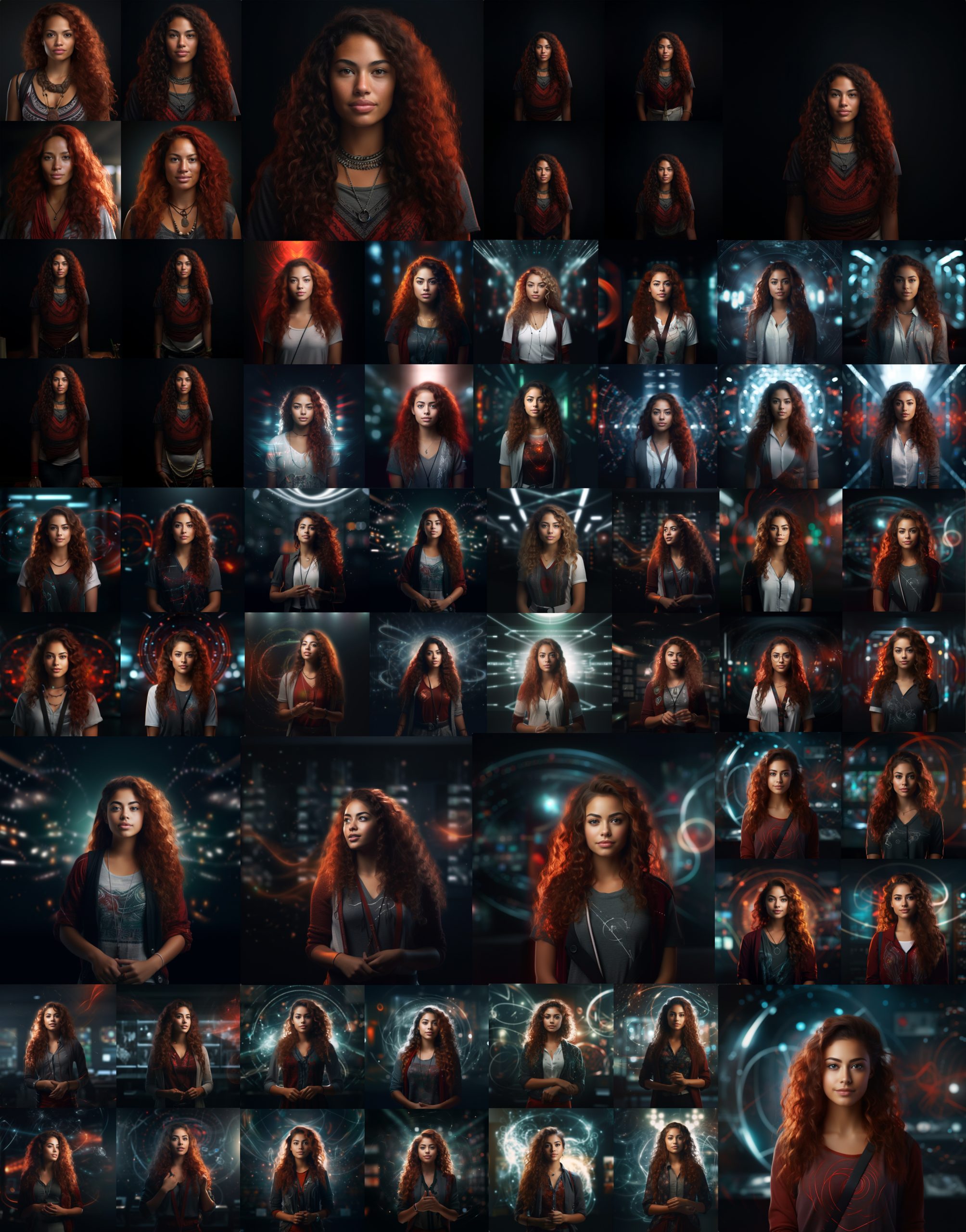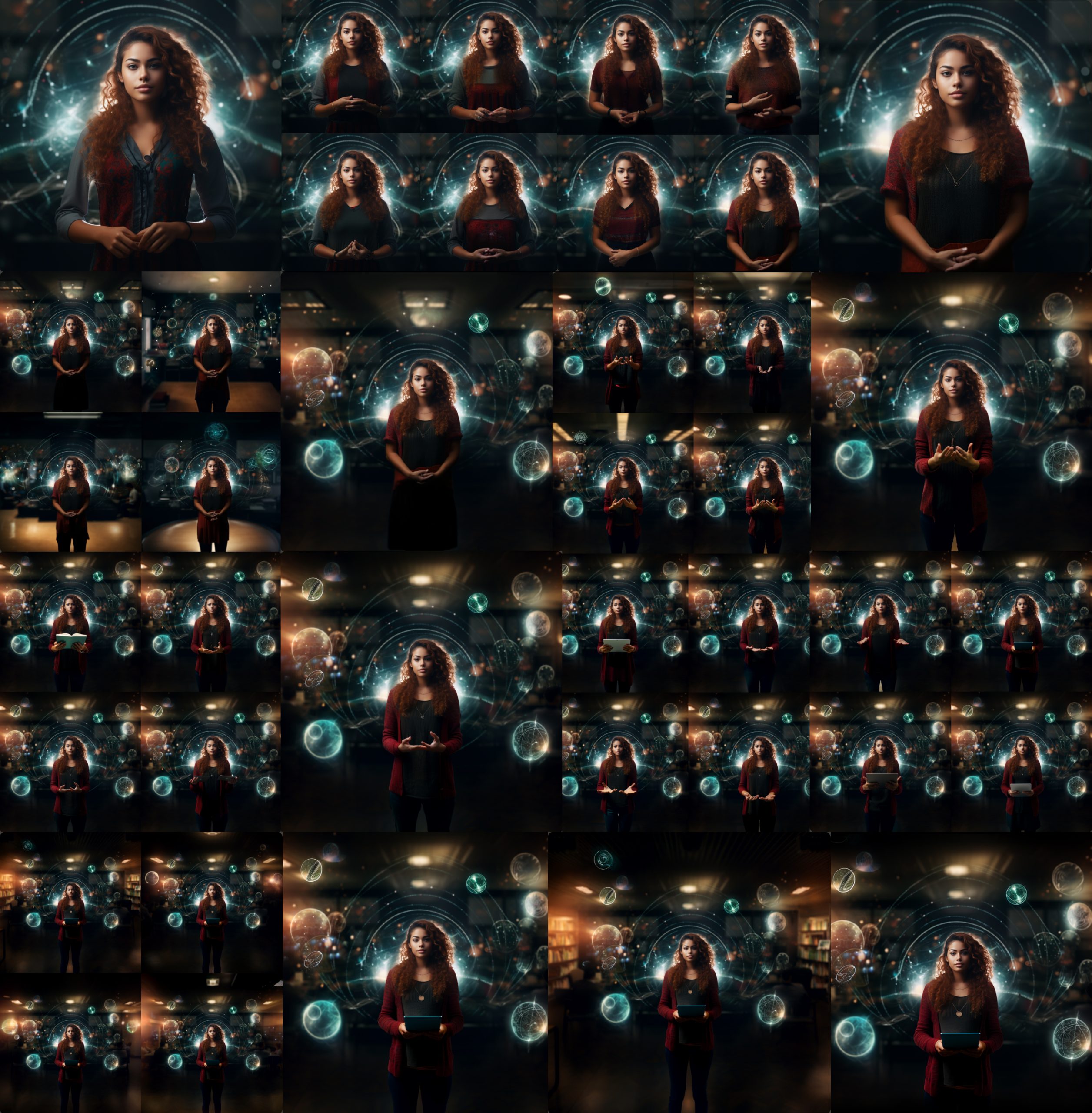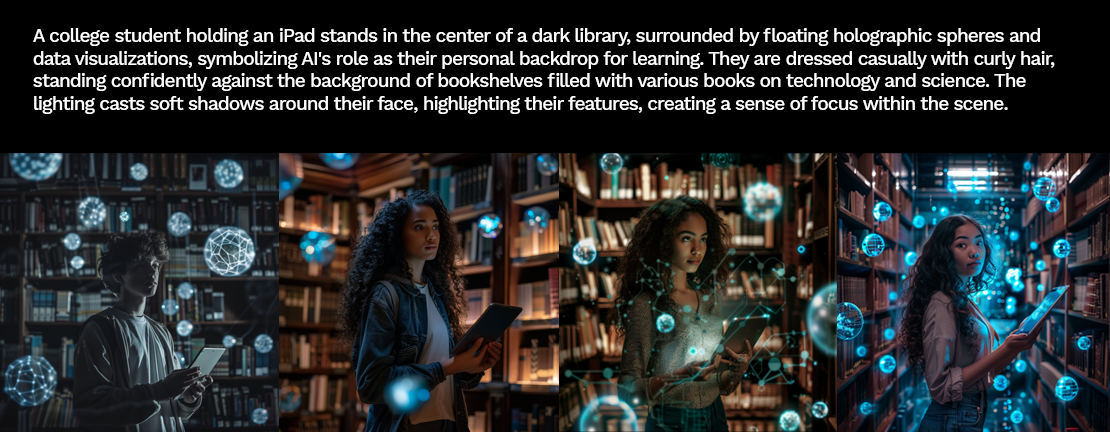Introduction
Beth Buyserie and Travis N. Thurston
Knowledge emerges only through invention and re-invention, through the restless, impatient continuing, hopeful inquiry human beings pursue in the world, with the world, and with each other.
—Paulo Freire (1970, p. 45)
With the rapid development of generative AI, teachers are experiencing a new pedagogical challenge, one that promises to forever change the way we approach teaching and learning. As a response to this unprecedented teaching context, this collection—Teaching and Generative AI: Pedagogical Possibilities and Productive Tensions—provides interdisciplinary teachers, librarians, and instructional designers with practical and thoughtful pedagogical resources for navigating the possibilities and challenges of teaching in an AI era. Because our goal with this edited collection is to present nuanced discussions of AI technologies across disciplines, the chapters collectively acknowledge or explore both possibilities and tensions—including the strengths, limitations, ethical considerations, and disciplinary potential and challenges—of teaching in an AI era. As such, the authors in this collection do not simply praise or criticize AI, but thoughtfully acknowledge and explore its complexities within educational settings.
Throughout this collection, the authors also provide insight on various forms of critical digital pedagogy, which builds on the work of multiple liberatory scholars, including Paulo Freire and bell hooks (1994). Critical digital pedagogy is an educational approach that combines critical theory with digital technology to question and shape the ways digital tools are used in teaching and learning environments (Aguilera & Salazar, 2023). In Pedagogy of the Oppressed, Freire (1970) takes a critical view of unchecked educational constructs and advocates for a more liberating and empowering approach to education. Though Freire’s work obviously precedes open-AI platforms like ChatGPT, his argument still resonates in our AI era: suppressing critical thinking limits the autonomy of our students and ultimately dehumanizes, or oppresses, them. As teachers in this AI era, it’s essential to empower learners—including teachers as learners—to think critically and support each other as agents of our own education, thereby fostering our development and, ultimately, our humanization. By foregrounding critical digital pedagogy in this collection, students and teachers can collaboratively analyze and consider both the challenges and the opportunities that technologies like AI bring to the learning process.
Additionally, Morris & Stommel (2018) argue that critical digital pedagogy asks more questions than it answers—and we expect that this collection may also spark more questions than it will answer about AI in the college classroom, ultimately inspiring more inquiry and more knowledge-building. By engaging in discussions about how AI impacts learning constructs, we hope to continue the restless inquiry of knowledge-building together. Therefore, as readers consider the practical ideas shared by the authors of this collection, we encourage teachers and students to critically reflect on the tensions and possibilities discussed in these chapters. Below are some recommended reflection prompts to guide learners in this process:
- Consider the potential impact of AI on equity and access in higher education. What measures can be put in place to ensure that all students benefit from AI technologies regardless of their background?
- Reflect on the implications of AI for trusting student autonomy in the learning process. How might the use of AI to complete assignments challenge traditional notions of authorship and originality?
- Identify essential habits of mind for students like critical thinking, metacognition, flexibility, and innovation. How does the integration of AI into teaching and learning reshape the skills that students are expected to develop during their college education?
- Evaluate the role of the instructor in an AI-enhanced learning environment. How might the use of AI shift the instructor’s responsibilities and pedagogical strategies?
- Analyze the ethical considerations of using AI in educational settings. How can educators balance the benefits of personalized learning with the need to protect student privacy and data security?
In addition to the reflection prompts above, we have included (with the assistance of ChatGPT) a box titled “Questions to Guide Reflection and Discussion” at the end of each chapter. In these boxes, we provide specific and applicable questions for readers to consider through each chapter of this edited collection. For those reading on their own or for a class, the questions can be utilized for personal reflection or class inquiry; those participating in a learning circle or book club can utilize the questions to spark discussion within a group.
Connecting Critical Digital Pedagogy to Iteration and the Learning Process: A Visual AI Example for Classroom Analysis
To illustrate the possible ways in which teachers, librarians, and instructional designers can use the resources in this book to enhance student learning, here we present a brief visual example of how AI can be used to teach iterative revision and analysis. As readers may have guessed, the image for the book cover (Image 1) was created using AI, specifically the platform Midjourney, an AI-powered image creator that transforms textual prompts into stunning visual images.
Image 1: Final Book Cover for Teaching and Generative AI

While readers might initially assume that this visual was the first image Midjourney produced in response to a prompt, in reality this image was created through an iterative process that required multiple stages of prompt revision, analysis, and critical thinking. Below we include the iterative drafts of this visual to make visible the critical thinking, content knowledge, and reflective analysis required to successfully shepherd any project from the stages of concept design and brainstorming to the final product. Although revision is an ongoing process, even experienced writers and designers can easily assume that a final image or text was created almost instantaneously and effortlessly, simply because the author is considered to be an expert at their craft. The speed with which generative AI produces outputs can further enhance this notion that good writing or design is, or should be, inherently swift. In the context of AI, presenting only the final product of a text or image can unintentionally reinforce that revision, a crucial component for learning, is only required for “novice” learners. Instead, the visual example below—and the collective message of the book—is that any project, regardless of whether or not it is shaped through the assistance of generative AI, requires considerable analysis, critical thinking, and contributions from the humans involved in the process.
Rather than an instantaneous output, the process of generating this AI image concept to a final book cover required multiple iterations—over 40 from beginning to end—which illustrates in visual detail the revision process college students engage in when demonstrating learning for projects ranging from a research paper to a final creative portfolio. Image 2 shows the first iterations of the book cover, beginning with a prompt asking for a college student as the subject and then zooming out away from the subject. Next, prompts were added to include abstract light and AI technology in the background. After identifying the main subject for the cover, Midjourney continued to produce alterations to the facial structure, the hair style, and the clothing of the subject; Midjourney also altered the background of the image (Image 3). By zooming out further and adding a library setting into the background and a tablet in the hands of the subject, the image was finally completed (Image 1). The full process from start to finish took several weeks, with the co-editor making small changes and refining prompts along the way.
Image 2: Initial Progression of AI-Generated Images in Midjourney for Final Book Cover

Image 3: Continued Progression of AI-Generated Images in Midjourney for Final Book Cover

Both iterative AI-image creation and student learning involve cycles of feedback, reflection, and adjustment. Just as adjusting prompts refine AI images, students engage in learning through experience, reflecting on that experience, abstract conceptualization of knowledge, and applying new concepts to real-world contexts. Both processes are dynamic and iterative, emphasizing growth and improvement through continuous engagement and adaptation. Both processes—whether creating a visual piece with AI or writing an academic paper to showcase knowledge—demonstrate the critical importance of ongoing revision and the necessity to re-evaluate and improve upon one’s work throughout the learning process.
Iteration Exercise
One way to engage students in this discussion on the importance of iteration is to have them experience AI image creation firsthand. Start by showing students a list of descriptive words or describe to students an image that you’d like them to try to create. For example, they might be instructed to “create an image of a college student standing in a library using a tablet.” The image used for the cover of this book could be a model for them to follow.
Share with students that there isn’t one correct answer: they will not only be creating an image based on the criteria of the example, but also critically analyzing the image they do create. Before the students begin, show them a secondary example of what happens when inputting the exact same prompt from Image 3 back into Midjourney and analyzing what it produces:
Sample Prompt: A college student holding an iPad stands in the center of a dark library, surrounded by floating holographic spheres and data visualizations, symbolizing AI’s role as their personal backdrop for learning. They are dressed casually with curly hair, standing confidently against the background of bookshelves filled with various books on technology and science. The lighting casts soft shadows around their face, highlighting their features, creating a sense of focus within the scene.
Image 4: Sample AI-Generated Images Using Midjourney Descriptive Prompt from Image 3

This exercise can be followed by encouraging students to consider other questions that may be sparked as they iterate through AI image creation, or asking students to critically reflect on sample questions like these:
- Who or what does the AI select to represent the initial textual prompt? How is the image portrayed? What values or perspectives does the image reflect? Does the image support your own perspectives? The perspectives of another community? The perspectives of a community you need to learn more about?
- What specific prompts do you think the co-editor might have used to revise the images presented above? Why do you think the co-editor decided to keep revising both their prompt and the AI image at each stage of the process? How does each successive revision help communicate the purpose and message to the audience of this book?
- How might different initial prompts and descriptive words influence the diversity of AI-generated images, and what does this reveal about the importance of framing inquiry questions?
- In what ways can the iteration process in AI image creation help you understand the value of feedback in your own learning journey?
- How has your experience in creating AI-generated images impacted your critical thinking skills? What was your thought process in revising the prompts you used?
- In what ways has this exercise impacted your understanding of the need for iteration and intentionality in your own learning process?
This visual exercise provides a low-stakes way for students to interact with AI and to discuss important topics with each other to co-create knowledge and spark more inquiry. Encouraging students to self-reflect and discuss deeper conversations about the roles of AI in student learning—and can further support students to think more critically for themselves about how they understand and use AI.
Overview of Teaching and Generative AI
In addition to the visual example highlighted above, this edited collection provides many pedagogical resources for teaching both with and about generative AI. To include multiple perspectives on generative AI in education, this collection features authors who teach a variety of subjects, including chemistry, composition, creative writing, film, history, informational literacy, instructional design, media literacy, music, psychology, and technical and professional communication at both the undergraduate and graduate levels; the book also features insights by librarians and instructional designers from various institutional settings. The chapters range from assignment prompts and activity descriptions, IRB-approved research studies, theory-informed pedagogical discussions, and teacher reflections on curricular revisions. Individual chapters can be used as course readings in both undergraduate and graduate courses, professional development sessions, and instructional design settings—both for audiences who have significant expertise in teaching with AI and for those who are new to (or perhaps resistant to) the technology. Regardless of the context, the collection investigates and questions how our teaching practices might thoughtfully and productively respond to this current teaching context—and seeks to prepare educators to respond productively to future shifts in teaching with generative AI.
The book contains 35 chapters and is separated into the following six sections:
- Section 1: Framing Concepts
- Section 2: Research Studies
- Section 3: Race and Indigenous Studies
- Section 4: Humanizing Technology
- Section 5: Teaching Resources
- Section 6: Disciplinary Approaches
Section 1: Framing Concepts
While maintaining their focus on pedagogy, the chapters in this “Framing Concepts” section provide students and teachers with more theoretically-informed discussions on AI. Collectively, these chapters introduce students to the language, theories, and concepts necessary to engage critically with conversations on AI. Here are highlights from three of these chapters:
- “Empowering Educators in the Age of Generative AI: A Critical Media Literacy Approach” by Ali Söken and Kysa Nygreen. In this first chapter of the collection, Söken and Nygreen introduce the framework of Critical Media Literacy (CML), which “refers to the practice of analyzing media texts as social constructs that shape, and are shaped by, societal discourses, ideologies, systems of power, and cultural narratives.” Because their Education and Film class emphasizes social justice, the authors describe how CML is a useful framework for analyzing and challenging the unhelpful binary of “protective” vs. “celebratory” media conversations on AI.
- “Some Ethical Considerations for Teaching and Generative AI in Higher Education” by Lydia Wilkes. In this chapter, Wilkes highlights multiple ethical issues surrounding AI, including environmental concerns, labor issues, data and privacy, and algorithmic bias against marginalized populations—all of which provide a framework for discussing intersections of AI, power, and justice.
- “Developing Students’ Media and Information Literacy through Open Dialogues” by Rosa Thornley and Dory Rosenberg. In this chapter, the authors—a composition instructor and a librarian—present an approach that both engages students in dialogue on AI and teaches information literacy. As the authors note, “digital literacy [i]s a prerequisite for AI literacy” and incorporating information and AI literacies can “support students’ progress towards becoming credible creators of information.”
Section 2: Research Studies
At the time of our call for chapters in May 2023, relatively few IRB-approved research studies on student learning and AI existed. The chapters in this “Research Studies” section, therefore, document early human subjects research on teaching with AI. Though more studies will undoubtedly be published in the future, the studies in this chapter provide important insights into how teachers might productively examine and assess student learning when using AI—and provide teacher-researchers with helpful models for how to set up their own research design for future studies. Below is a brief description of some of the research studies in this section:
- “More is Less? Using Generative AI for Idea Generation and Diversification in Early Writing Processes” by Franziska Tsufim and Lainie Pomerleau. In this chapter, Tsufim and Pomerleau document student responses to two idea-generation exercises designed for a technical and professional communication course. In their discussion section, the authors use evidence from student self-assessments to identify 1) that students felt more confident sharing their early writing when they were supported by AI, and 2) concerns that initial student use of AI resulted in somewhat generic analysis. In response to their findings, the authors suggest ways of revising the prompts to promote more specific engagement with course concepts.
- “Automated Aid or Offloading Close Reading? Student Perspectives on AI Reading Assistants” by Marc Watkins. In this chapter, Watkins introduces us to two AI-generated reading tools, Explainpaper and SciSpace, that summarize and explain research and scientific papers in understandable language. Watkins’ study assesses how the use of these tools affected student learning; at the end of the chapter, he provides recommendations for when teachers might have students supplement their learning with these tools—and when teachers and students should practice caution to ensure the tool does not replace student learning.
- “Use, Benefits, and Limitations of AI Chatbots: Implementing ChatGPT in the First-Year Writing Classroom,” co-authored by Walker P. Smith and seven of his undergraduate students in an Honors Composition class. In this chapter, Smith et al. engaged in a multi-phase research study where they 1) used ChatGPT to revise several essays written for a separate first-year composition course; 2) asked ChatGPT to write from scratch, and then revise, essays that responded to the same assignment prompts; 3) invited other composition teachers to assess and compare the original student writing, the hybrid AI-revised essays, and the AI-created essays; and 4) interviewed the teachers to garner insights on their assessment process. After analyzing their findings, Walker and the undergraduate students provide recommendations for AI use in writing courses.
Section 3: Race and Indigenous Studies
This section plays an important role in this book—each chapter asks readers to thoughtfully consider how concepts of race and Indigenous studies affect our interactions with AI. This section’s chapters were each written by members and affiliates of Utah State University’s research cluster on Race, Ethnicity, and Indigenous Studies, which is sponsored by USU’s Center for Intersectional Gender Studies and Research. The format for these peer-reviewed “mini-chapters” was inspired by journals that periodically publish shorter symposium pieces—brief expert reflections, based on research and lived experiences, designed to encourage further in-depth conversations on, in this case, intersections between race, Indigenous studies, and AI. The section authors represent a variety of disciplines, including cultural studies, education, game design, instructional technology, literature, psychology and clinical counseling, quantitative experience design, social science research, and STEM education. We hope you take time to reflect on the insights of the following chapters:
- “Broadening Applications of Artificial Intelligence in Education to Include Indigenous Ways of Knowing” by Megan Hamilton
- “Race Against the Machine” by Samantha Yoder
- Cultural Reproduction: AIs Interrupting the Cultural Healing Work of Teachers” and “Rude Reflections” by Ofa Fotu
- “Indigenous Futures in Generative Artificial Intelligence: The Paradox of Participation” by Rogelio E. Cardona-Rivera, Melissa Tehee, Breanne Litts, and J. Kaleo Alladin
- “Co-Creating Intersectional Design Narratives with AI” by Ha Nguyen
- “Use of AI in Teaching Social Statistics or Data Analysis” by Mudasir Mustafa
- “Epistemological Clash: AI and Ways of Knowing” by Emma Mecham
- “Cheating as a Symptom, Not Disease” by Adena Rivera-Dundas
Section 4: Humanizing Technology
This section on “Humanizing Technology” highlights the human connections and interactions with AI technology. The authors in this section collectively emphasize that, regardless of how AI is approached, our pedagogical commitments should always foreground student and teacher learning and experiences. This commitment is why, for example, we as the editors of this collection chose to include a picture of each author at the end of their chapter. (We wanted each author’s picture to appear at the beginning of their chapter—but ironically the platform we used to create this digital book doesn’t allow humans to have unlimited choice on image placement.) Within this section, you can find chapters on a range of human-focused connections to AI, including the following:
- “Wrestling with A.I.” by Catherine J. Denial. In this chapter, Denial, a history professor, helps us consider the benefits of slow responses to ever-changing technology, of allowing ourselves the time and mental space to make thoughtful and informed decisions about how we engage with AI. Denial describes the ways in which she and her students deliberately took the necessary time to reflect on AI readings and concepts, concluding that “as AI speeds up the pace of change in multiple areas of our lives, it feels incredibly and importantly human to insist that some of our best thinking comes when we carefully, thoughtfully slow things down.”
- “My Summer with ChatGPT” by Mary Lourdes Silva. Silva, who teaches first-year composition, opens the chapter by describing how AI assisted her at a time when she was healing from several injuries, an experience that connected the human with the technology in rewarding ways. As a bilingual speaker whose first language is not English, Silva also thoughtfully complicates arguments regarding AI’s impact on linguistic diversity and standardization of language, noting that AI-assistive technologies can help multilingual writers mitigate the cognitive workload required to continuously navigate the linguistic conventions of another language. By documenting the tensions in her own lived experiences with language and learning, Silva emphasizes that “good writing comes from those moments of struggle—but it is not sustainable mentally and emotionally to persist indefinitely in those liminal spaces.”
- “Examining Ways of Using AI to Better Support Teaching Faculty, Mitigate Burnout, and Increase Teaching Creativity” by Jennifer Grewe. In this chapter, Grewe, whose discipline is psychology, addresses the important topic of teacher burnout and discusses how teachers might utilize AI to increase student interest, enhance creativity in course design, and decrease teacher workload.
Section 5: Teaching Resources
Because the heart of this collection seeks to provide concrete pedagogical strategies for teaching with AI, this section on “Teaching Resources” contains nine chapters that describe a range of pedagogical assignments, approaches, and activities. While we encourage you to read all chapters in this section in full, below are a few highlights:
- “Cake-Making Analogy for Setting Generative AI Guidelines/Ethics” by Maha Bali. In this chapter, Bali uses the analogy of making a cake from scratch, making cake from a box, buying a professional cake from a bakery, and buying a packaged cake from a grocery store to help students think critically about when and for what purposes they might use AI. The entertaining analogy sparks interesting conversations on AI, and the chapter is easily accessible for first-year students.
- “Revisioning a Bibliography Assignment to Center Discovery and Critical Source Engagement” by Lillian Campbell, Jenna Green, and Nicole Bungert. The authors, two composition teachers and an instructional librarian, provide a thoughtful revision of a common research assignment: the annotated bibliography. As the authors note, the common version of an annotated bib, which asks students to summarize their research articles, is a task that ChatGPT can accomplish relatively easily. Their goal in revising this assignment is not to make it “ChatGPT-proof,” but to use the advent of AI to reflect on the assignment’s learning goals, increase student engagement with their research experiences, and “center the process of inquiry” in research.
- “Creating Constitutions with ChatGPT” by Julia M. Gossard. In this chapter, Gossard presents an IRB-approved study exploring how history students can use AI to create and assess a key historical primary document: a constitution. In this study, students first wrote their own constitution based on course material and then asked ChatGPT to write and revise a constitution based on the same materials. Students compared and evaluated the differences in the constitutions and reflected on their learning throughout the assignment.
- “An AI Workshop for the Overwhelmed and Uninterested” by Ritamarie Hensley. In this chapter, Hensley describes a workshop that instructional designers can provide to teachers, focusing on three audiences that may not change as quickly as AI technology: those who are overwhelmed, those who are not interested in using AI, and those who do not know where to start with the technology. Hensley also introduces readers to AI-driven “Teaching Tools” and “Perplexity.”
- “Collaborative Writing and AI: A Research Assignment for an Undergraduate Professional Communication Course” by Beth Buyserie. In this chapter, Buyserie provides the design, rationale, and prompt for a group assignment where professional communication students 1) conduct outside research on a specific AI-related topic, 2) conduct primary research with AI itself, and 3) make recommendations to their peers and future colleagues on how to effectively use AI and assess its output. Students also make recommendations for evaluating and responding to a range of disciplinary conversations on the technology.
Section 6: Disciplinary Approaches
Finally, in this section we highlight chapters that provide disciplinary-specific approaches to teaching with AI:
- “Using Generative AI in the Music History Classroom” by Reba Wissner. In this chapter, Wissner introduces four AI tools that can be used to enhance learning in a music history class, as well as introduce students to potential limitations of AI in musical contexts.
- “ChatGPT Assistance in Creating Chemistry Practice Problems: Pitfalls, Positives, and Possibilities” by Michael A. Christiansen. In this chapter, Christiansen explores how AI can be used to assist chemistry teachers as they provide meaningful examples to students. After analyzing Christiansen’s interactions with AI, readers also quickly realize that AI cannot serve as a substitute for their content knowledge —instead, students themselves must also be experts in their content in order to effectively evaluate and revise AI’s output.
- “‘Language Weaves Its Tapestry’: Crafting Found Poetry Using AI Tools” by Ruth Li. In this chapter, Li provides us with an approach to teaching creative writing with AI. The assignment asks students to use AI-generated text (of multiple genres) as the basis for their found poetry; it also encourages students “to experiment with new or surprising meanings, including meanings that might conflict with or go beyond the meaning of the AI-generated text.” Li’s sample poems are simply lovely—and they help teachers and students resist the idea that AI-generated text must always be static and lifeless.
- “Using Generative AI to Perform Stacked Evaluations of Educational Documents” by Susan Codone. This IRB-approved study is one of several chapters in the collection to focus on a little-discussed context for teaching with AI: graduate courses. In Codone’s chapter, education graduate students utilize AI to create a “stacked evaluation” of a school district technology plan.
References
Aguilera, E., & Salazar, C. (2023). Critical Digital Pedagogy in the Platform Society. Oxford Research Encyclopedia of Education.
Freire, P. (1970). Pedagogy of the oppressed. New York: Seabury Press.
hooks, b. (1994). Teaching to transgress: Education as the practice of freedom. Routledge.
Morris, S. M., & Stommel, J. (2018). An urgency of teachers: The work of critical digital pedagogy. Hybrid Pedagogy.



